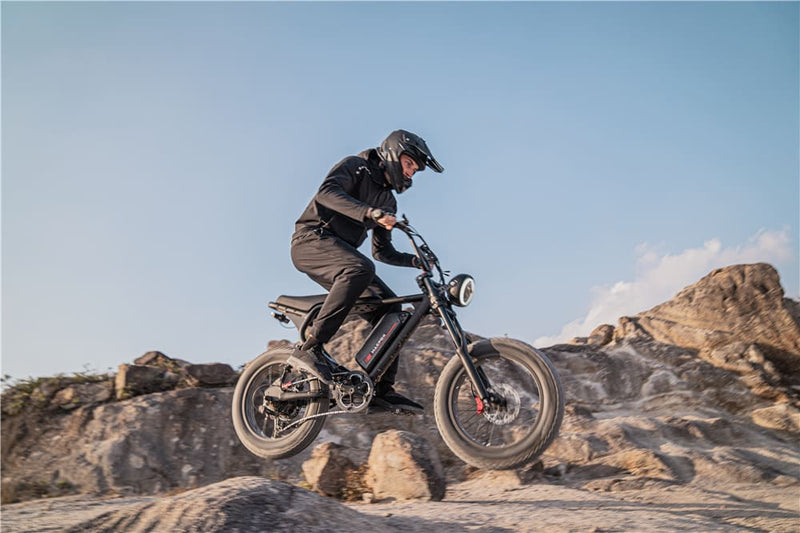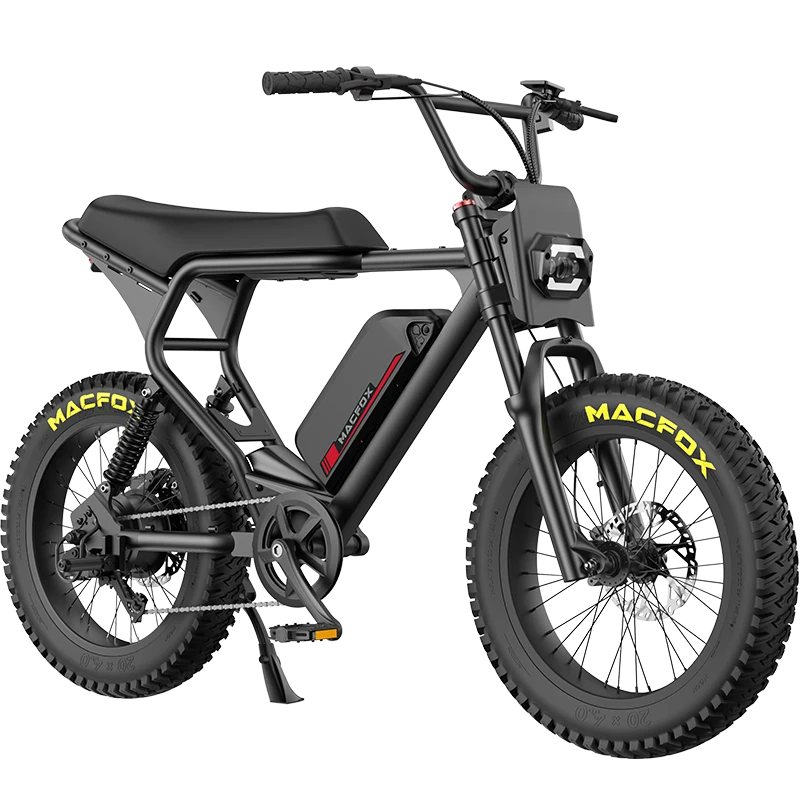Electric bikes (often referred to as e-bikes) have dramatically changed the cycling landscape by combining standard bicycles with innovative technological improvements. This mix offers an exceptional set of difficulties and discovery curves, especially for experienced cyclists transitioning from traditional bikes to e-bikes. While the core principles of riding remain, the addition of electrical components brings a whole new dimension to the riding experience. It's not really about pedaling and balancing anymore; understanding the mechanics and features of an e-bike is crucial. This includes understanding how electric assist works, how it affects the handling of the bike, and the overall impact on the riding experience. For experienced cyclists, this transition can be very difficult. They may find that they underestimate the nuances of operating an e-bike, which can lead to mistakes that not only reduce their riding enjoyment, but also compromise their safety and the bike's long life.
Neglecting Battery Care and Maintenance

E-bike batteries are sophisticated and important parts that require constant and mindful maintenance. Many bikers, accustomed to the low maintenance of conventional bikes, frequently neglect this element. Batteries require to be billed appropriately - not simply in terms of duration however additionally considering the setting in which they are billed. Saving and billing batteries in extreme temperature levels can be destructive to their lifespan and efficiency. In addition, it's important to prevent letting the battery drain entirely before charging, as this can create permanent damages gradually. Following the manufacturer's standards for charging cycles and storage space conditions is crucial. Experienced bicyclists may additionally neglect the demand to routinely inspect the battery's connections and sanitation, which can affect the bike's efficiency. In addition to these, comprehending the variety limits of the battery and preparation adventures as necessary is a skill that needs to be created to stay clear of being stranded with a diminished battery.
Check out Macfox’s blog post about battery maintenance in more detail:Optimizing the Lifespan of Electric Bicycle Batteries
Overlooking Regular Bike Maintenance
While the electric parts of e-bikes often take spotlight, it's vital not to forget the fundamental bicycle maintenance elements. This includes regular checks and changes of tire stress, brake pads, chains, equipments, and ensuring that all mechanical components are in good working condition. Routine maintenance not just ensures a smooth and effective adventure yet also prolongs the life of the bike. Experienced bicyclists might think that their regular maintenance knowledge and abilities are directly transferable to e-bikes. Nonetheless, e-bikes have added factors to consider due to their much heavier weight and the stress this places on numerous parts. As an example, the boosted weight can cause much faster wear and tear of brake pads and tires. Likewise, the electrical system needs routine checks to ensure all links are secure and operating properly. Normal expert servicing is recommended to make sure that both the mechanical and electrical systems are running efficiently.
Off road electric bike for experienced riders:
| https://macfoxbike.com/products/macfox-x2 |
Misjudging Speed and Braking Distance
Among the most tempting functions of e-bikes is their capacity to get to higher speeds with less effort compared to standard bikes. Nevertheless, this can lead to an important miscalculation in regards to stopping ranges. The boosted rate, combined with the bike's included weight, significantly influences the momentum, needing a greater range to find to a total stop. Experienced bikers may not initially value this difference, resulting in dangerous scenarios, specifically in traffic-heavy city environments. It is essential to practice and get a feel for the bike's stopping reaction in a risk-free area before heading right into even more difficult atmospheres. This includes understanding just how the bike's weight distribution and speed impact braking effectiveness and adjusting riding routines accordingly. Preparing for stops and using brakes earlier than typical is a vital skill that needs to be honed for secure e-bike riding.
Underestimating the Importance of a Proper Fit
The fit of an e-bike is just as important, otherwise even more, as that of a standard bike. This is because the riding dynamics transform with the addition of electrical help. An incorrect fit can lead to discomfort, inefficiency, and also security dangers. Experienced bikers may forget this, assuming that their previous bike fit will certainly be sufficient. However, because of the various balance factors and weight circulation of e-bikes, an appropriate suitable session with a professional is recommended. This includes adjusting the seat elevation, handlebar placement, and even the pedal type to match the rider's body measurements and riding style. A well-fitted e-bike can significantly improve riding convenience and control, making the experience more delightful and more secure.
Related Reading: Should E-Bikes Be Given Vehicle Status?
Ignoring Local Laws and Regulations
E-bikes are in a different category than traditional bikes in terms of regulations and regulations, and the categories of e-bikes can vary significantly depending on the region. Many skilled cyclists make the mistake of not being familiar with these guidelines, which may include specific speed limits, helmet requirements, and marked locations where e-bikes can be legally used. For example, some areas actually allocate specific trails for e-bikes, while others may restrict their use in specific areas. A lack of understanding of these legislation can result in penalties, bike confiscation, or even more extreme legal consequences. Additionally, adhering to these policies ensures the safety of cyclists and those around them. It is important to research and be aware of regional legislation relating to the use of e-bikes (including any type of updates or modifications to these laws).
Failing to Adapt Riding Style for Different Terrains
E-bikes manage in different ways than typical bikes, specifically on varying terrains. Experienced bicyclists could not instantly adapt their riding design to fit these differences. As an example, on off-road terrains, the greater torque of e-bikes can bring about an extra aggressive beginning, which may capture a biker unsuspecting. Likewise, browsing with limited rooms or corners calls for a different strategy due to the bike's weight and speed abilities. Understanding and exercising just how to handle an e-bike in different surfaces is crucial. This includes readjusting the degree of electrical assist based on the surface, learning just how to steer the bike effectively, and being aware of the bike's limitations in extreme conditions.
Recommended electric commuter bike for beginners:
| https://macfoxbike.com/products/macfox-x1 |
Overconfidence in Skill Level
Transitioning to an e-bike can sometimes result in overconfidence amongst knowledgeable cyclists. The additional power and speed supplied by the electrical help can give a false sense of mastery over the bike. Nonetheless, this insolence can cause taking unneeded dangers or failing to work out the care required for safe e-bike operation. It is very important to technique e-biking with an attitude of knowing and regard for the brand-new characteristics it introduces. Beginning with reduced assist levels and slowly raising as one obtains even more comfortable with the bike's handling is a prudent approach. Furthermore, bearing in mind the environments and riding defensively, particularly in high-traffic areas, is critical for security.
Disregarding the Extra Weight of E-Bikes

E-bikes are naturally much heavier than conventional bikes as a result of their electric motor and battery. This included weight impacts the bike's handling, particularly in regards to balance, turning, and quiting. Experienced cyclists might not at first account for this difference, which can lead to mishandling, especially in emergency situation situations or when navigating via obstacles. Understanding exactly how the bike's weight circulation influences its stability and handling is crucial. This includes exercising turns, quits, and begins in a safe environment to get a feel for the bike's response. Additionally, the additional weight implies that transferring and saving the e-bike calls for more effort and potentially various tools than what is utilized for typical bikes.
Conclusion
E-bikes offer an exciting and boosted biking experience, blending standard biking elements with modern-day innovation. However, for experienced cyclists, the change to e-biking needs a change in mindset and adjustment to the special characteristics of these bikes. Awareness of upkeep demands, recognizing the influence of rate and weight, sticking to local guidelines, and guaranteeing correct bike fit are all important for a safe and pleasurable e-bike experience. By identifying and adapting to these distinctions, experienced bicyclists can totally welcome the benefits of e-biking while lessening common errors.
FAQs
What is the very best way to store my e-bike battery when not being used?
When saving your e-bike battery for a prolonged period, maintain it in a cool, completely dry area, far from severe temperatures. The battery should be credited about 40-60% of its ability, as storing it at full fee or completely depleted can reduce its lifespan.
How do I recognize if my e-bike fits me correctly?
An appropriately fitted e-bike should allow you to get to the pedals pleasantly without overstressing your arms or back. Your knees ought to have a minor bend when the pedals are at their lowest point. If you experience discomfort or strain while riding, take into consideration obtaining a specialist fit analysis.
Can I ride my e-bike like a regular bike without making use of the electric aid?
Yes, you can ride an e-bike without involving the electric help, essentially using it as a normal bike. Nonetheless, remember that e-bikes are heavier, so pedaling without help calls for a lot more effort, specifically on inclines or over longer distances.


















